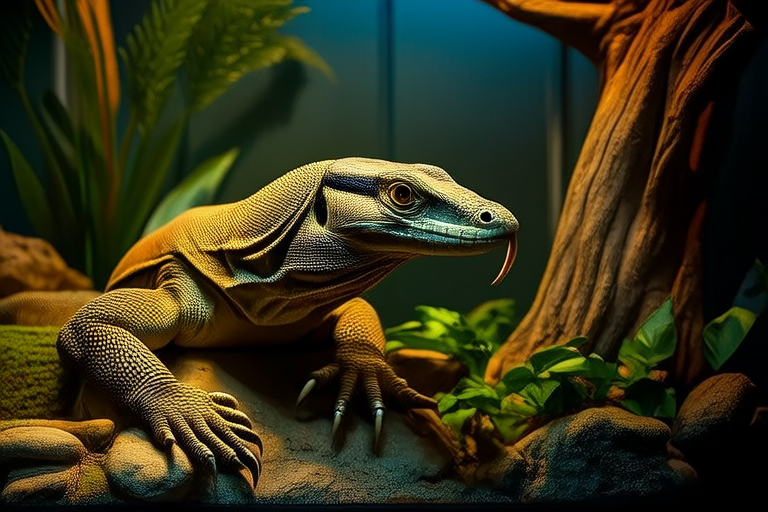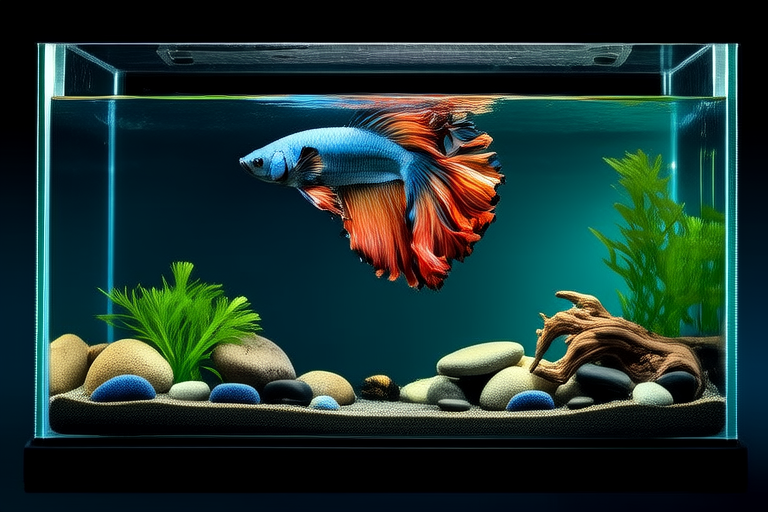
How to Care for Your Water Monitor: A Comprehensive Guide
Water monitors (Varanus salvator) are among the largest lizards kept as pets, and they require specialized care to thrive. This guide will walk you through setting up their habitat, meeting their dietary needs, understanding their health care requirements, social behavior, handling tips, and common challenges faced by owners.
Habitat Setup
Creating an appropriate environment is crucial for your water monitor’s well-being. Start with a large enclosure that allows ample space for swimming and climbing. The tank should be at least twice the length of your monitor, with a depth that accommodates swimming. For example, a 6-foot long monitor would need a tank around 12 feet long. Ensure there’s a secure lid or mesh top to prevent escapes.
Adequate lighting is essential. Use UVB lighting to help your monitor synthesize vitamin D3, which aids in calcium absorption. Position the light so it covers most of the tank, but avoid placing it directly above the basking area to prevent overheating. Supplemental heat lamps can provide a basking spot, maintaining a temperature gradient within the enclosure. The basking area should reach around 95°F, while the cooler end remains between 75-85°F.
Water quality is paramount for a water monitor. Use a powerful filtration system to maintain clean water, as these lizards spend significant time in it. Regular water changes are necessary to keep ammonia and nitrite levels low. A submersible heater can help maintain water temperatures between 82-86°F, mimicking their natural tropical environment.
Dietary Needs
Water monitors are carnivorous and require a varied diet to ensure proper nutrition. Feed them a mix of live prey items such as mice, fish, crickets, and mealworms. Younger monitors can eat smaller prey, while adults can handle larger food items like chicks and rats. Feed juveniles daily, reducing to every other day for adults.
In addition to live prey, offer occasional treats like boiled eggs or fruits. It’s important to gut-load feeder insects with nutritious foods before offering them to your monitor. Dusting prey with a calcium supplement can help prevent metabolic bone disease, especially during growth stages.
Health Care
Regular veterinary check-ups are crucial for monitoring your monitor’s health. Look for signs of illness, such as lethargy, loss of appetite, or unusual discharge. Skin conditions, respiratory infections, and parasites are common issues. Keep the enclosure clean and maintain proper humidity levels to prevent skin problems.
Vaccinations are not required for reptiles, but routine fecal exams can help manage internal parasites. Always quarantine new additions to the household to prevent introducing diseases into your current setup. Consult a veterinarian specializing in reptiles for guidance on preventive care and treatment options.
Social Behavior
Water monitors are generally solitary animals in the wild, and this behavior extends to captivity. They can be territorial and may display aggression towards other monitors. It’s best to house them individually to avoid stress and potential injuries. While they might tolerate some interaction from their owner, they are not typically social pets in the same way dogs or cats are.
Despite their solitary nature, water monitors can form bonds with their handlers over time. However, patience and consistency are key. Establish a routine that includes regular feeding and gentle handling to help your monitor become more comfortable around you.
Handling Tips
Water monitors have strong jaws and claws, making them potentially dangerous if mishandled. Always approach your monitor calmly and confidently. Allow it to acclimate to your presence before attempting to pick it up. Support its body fully when handling to prevent injury to both you and your pet.
Use a hook or tongs to safely transfer your monitor between enclosures or when cleaning the tank. Never grab your monitor by the tail, as this can lead to a painful condition called tail-tip necrosis. Instead, gently scoop it up from behind or under its belly.
Common Challenges Faced by Owners
Maintaining the right balance of temperature, humidity, and water quality can be challenging. Many owners struggle with creating an optimal environment that meets all of their monitor’s needs. Research thoroughly before acquiring a water monitor to ensure you’re prepared for the commitment.
Budget constraints can also be a challenge, as water monitors require a significant investment in equipment and supplies. Additionally, the cost of veterinary care for exotic pets can be high. Consider these factors when deciding whether to bring a water monitor into your home.
Space limitations are another common issue. These lizards grow rapidly and require substantial living spaces. Ensure you have the room for a large enclosure and the ability to expand it as your monitor grows.
Finally, water monitors can be unpredictable. While many owners find them fascinating, their strong personalities and occasional aggressive tendencies can be off-putting for some. Be prepared for the possibility of bites and scratches, and always prioritize safety when interacting with your pet.
In conclusion, caring for a water monitor is a rewarding yet demanding responsibility. By providing a suitable habitat, a balanced diet, regular health checks, and consistent handling, you can ensure your monitor leads a healthy and happy life. Remember, each lizard is unique, so observe your pet closely to understand its individual needs and preferences.
For further reading, consult books and resources dedicated to reptile care, and join online communities where you can share experiences and learn from fellow enthusiasts.





